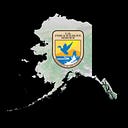Culinary Adventures at the Canning River Camp
Research crew tests their culinary skills and gets creative in a rustic kitchen in remote field camp.

Here’s lunch: a thick slice of raw red cabbage, a couple of slices of cheese, tucked between two pieces of wheat bread and slathered with organic hummus. You’ve got your veggies, protein, dairy and whole grains. Now that is a satisfying sandwich! Especially, after hiking for hours on the Arctic National Wildlife Refuge tundra counting birds or visiting fox research sites.
You’re not so sure?
OK. Let’s step back to look at where this sandwich was created.
Off the Grid
Here in this very remote northwest corner of Arctic Refuge, with mountains of the Brooks Range to the south and the icy Beaufort Sea to the north, conveniences of modern living are totally absent. Life on the tundra means no running water or refrigeration, no traditional stove or oven, and no grocery stores. Instead, a large weather port perched on a plywood platform serves as the kitchen. Campers gather here to prep and share meals and enjoy each other’s company. Every day begins and ends in this tent.

Food is stored in bear proof containers, big metal drums with lids. When it is time to cook, the lucky chefs pops the lids off the four-foot deep drums and start to dig, sometimes all the way to the bottom to find an elusive ingredient. Food deliveries are infrequent. Most of the foods have a long shelf life. There are a couple of coolers to store leftovers and a few fresh foods.




With a limited set of ingredients and equipment, the young, enthusiastic team of campers rose to the occasion and cooked up some meals to remember.
Typical Meals
Breakfast: In the morning, groggy researchers stumble in from their tents to get breakfast and make plans for the day. Most mornings, they are on their own. There are teas, coffee, cereals, pancake mix, peanut butter, jelly, dried fruits and sometimes fresh fruits, eggs and bread.


Occasionally, someone will make enough breakfast food to share. Like on the fourth of July, Maria Berkeland made pancakes for everyone. In keeping with the spirit of the day, she shaped rectangular pancakes, dropped raisin “stars” in one corner and squirted on red colored jelly “stripes.” Voila! American flag pancakes.

Lunch: Before heading out for a long day of work on the tundra, the campers make their lunches. When bread and sandwich fixings are available, it’s sandwiches to go. Remember the red cabbage sandwich? Otherwise, they make due with leftovers, crackers, snack bars, dried fruit, jerky, nuts, and whatever other snacks they can scrounge from the food-storage barrels.




Dinner: The first team to get back to camp in the evening, whips up supper, sometimes for as many as 12 people. “Not like 12 normal people, like 12 people who have been working out in the field all day and can really pile down some food,” said Tim Knudson. “It is like having a bunch of teenagers in the house.”
Even a seasoned chef might find feeding this crowd a challenge in the camp’s rustic kitchen. But the intrepid campers forge ahead to create meals to satisfy everyone.
One night, it’s soft tacos with all the fixin’s, including salsa, cheddar cheese, cabbage, and a very large can of jalapenos. On another, its freshly caught fish with fried potatoes and canned green beans. Being a “meat and potatoes” kind of guy, Tim Knudson, found this meal to be particularly satisfying.




And when a group of rafters stop by and donate some dates, cheese and bacon. . . Patty Eagan pulls together bacon wrapped cheese stuffed dates for an appetizer. Heaven!

Some nights there is even dessert! How about an apple crisp baked in a camp oven? Yum!



Looking back on the summer’s meals, “It is a lot of experimentation for some people,” Tim said. “ It been an adventure for everybody.”
Andrea Medeiros is a public affairs specialist for the U.S. Fish and Wildlife Service, Alaska Region.
In Alaska we are shared stewards of world renowned natural resources and our nation’s last true wild places. Our hope is that each generation has the opportunity to live with, live from, discover and enjoy the wildness of this awe-inspiring land and the people who love and depend on it.
